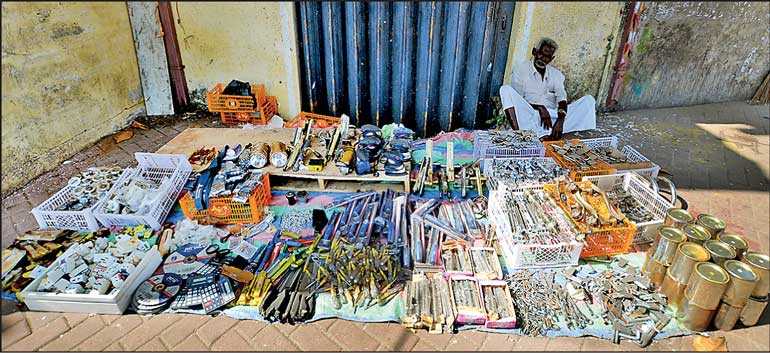Wednesday Mar 05, 2025
Wednesday Mar 05, 2025
Wednesday, 13 March 2019 00:00 - - {{hitsCtrl.values.hits}}

Shaved king coconut with straws. The ‘maalu’ shouts to the residents among the neighbourhood for salty fish. The knotted sacks of the laundry clothes in the tuk. Early morning whisk away of the newspaper at the doorstep. These hustles and bustles of the informal work have mellowed down, but it is still woven in city life.
The City of Colombo has transformed majorly through economic, social, political and spatial means. Street vending has survived through the reorganisations against the vying competition and demand for urban spaces and resources.
There is no reliable data on the number of street vendors in Colombo. But it is noticeable that there is a growth in the number of them. As a direct effect of urbanisation.
The three primary causes in the growth of street vendors are 1) In addition to poverty, less beneficial employment has made these workers migrate from rural areas to cities for better opportunities. 2) Workers who lost their jobs in the formal sectors were compelled to seek work in the informal sector as a survival strategy. Due to closures or downsizing in the factories. 3) A shortage of economic resources such as capital, property, and information to solve their situations.Street trading is the most popular option among various constraints in the urban economy’s informal sectors.
Street vendors use public spaces like roadsides, sidewalks, shop edges, marine drives, and crowded premise fronts to trade for their families’ daily needs. Be it the food stall in front of mosques, or garland shops outskirting temples or the ice cream bicycles in school fronts, street vendors work with the main activities of the region where they are located. To use it for development and reinforcement of the role of urban public spaces.
They receive direct visibility from passers-by and travellers in vehicles by placing the goods in the open which they hope will arouse buying interest. Prices are not taxed, they are cheap. The goods are in high demand among the people of the middle class. Also, they are quick in the fast-paced world as there are no receipts when effecting sales.
The trade is done through maintaining trust with raw materials in food businesses and purchasing vegetables directly from the farmers or wholesale businesses.
“My wife handles the money. I and my brothers take turns at the stall to reduce payment costs to others and supplement the family income,” said Anura, while he weighed the fruits for a customer in the scorching heat. They are exposed to sun, rain, noise, and pollution. And most of them are standing throughout the day. They are tremendously resilient and independent in the face of challenges.
Personally-motivated workers are frequently looked at as a public nuisance and have generated numerous debates around the world. Fishermen go out for catches in seasons that are not favourable despite the Government’s warned ban. Similarly, street vendors trade in prohibited places to earn some money. Vijith was threatened by a three-wheeler driver to stop selling soon to protect himself from arrest. How we handle the street vendors has not been very encouraging from people of all walks of life. The least good doers of the incense stick or naphthalene ball sellers are the ignorers or the sympathetic buyers. The frustration in the middle of traffic is understandable.
The city gloss and space demand have made the urban poor less attractive and unwanted. They are often considered as misfits against their urban structure, performance and physical appearance causing conflict in the space utilisation and visual representation.
The urban planners and Government must restructure the sector and fit them into the city by understanding their motivation for their location presence and recognising them as local identity. We should have a detailed survey study through vendor registrations and their place(s) of business to understand their needs and vulnerabilities. And to design aesthetically, well-planned and paced stalls to allocate vendors for their trading activities as in developed countries.
Fair and effective regulations and policies should comply with street vendors’ needs and welfare. Mumbai enacted its Street Vendors act in March 2014. After a decade of debate, Los Angeles has agreed to legalise street vendors in 2019. These are aspirational developments for the street vendor community which we could adopt from the other countries.
In cases such as health officers inspecting a food truck’s kitchen, consumers will also benefit. The government can provide a more secure place, such as the street vendors’ bazaar. Even women who make handmade goods and jaggery could get a space for their stalls. Locals and tourists everywhere enjoy street food and shopping if done appropriately. It can be a place for consumption and recreation.
A job reduces the criminality of a person. Work is the heart and soul of human life. And street vendors survive by working. We should all promote social inclusion and realisation of human rights.
These vendors have an entrepreneurial ethos that is not lower than that of formal entrepreneurs. By providing them with a level playing field, their potential could be developed and utilised for a better inclusive economy and society.
(The writer is a research writer and designer at SpaarkLab, an analytical storytelling agency. She can be contacted at [email protected].)
Discover Kapruka, the leading online shopping platform in Sri Lanka, where you can conveniently send Gifts and Flowers to your loved ones for any event including Valentine ’s Day. Explore a wide range of popular Shopping Categories on Kapruka, including Toys, Groceries, Electronics, Birthday Cakes, Fruits, Chocolates, Flower Bouquets, Clothing, Watches, Lingerie, Gift Sets and Jewellery. Also if you’re interested in selling with Kapruka, Partner Central by Kapruka is the best solution to start with. Moreover, through Kapruka Global Shop, you can also enjoy the convenience of purchasing products from renowned platforms like Amazon and eBay and have them delivered to Sri Lanka.
Discover Kapruka, the leading online shopping platform in Sri Lanka, where you can conveniently send Gifts and Flowers to your loved ones for any event including Valentine ’s Day. Explore a wide range of popular Shopping Categories on Kapruka, including Toys, Groceries, Electronics, Birthday Cakes, Fruits, Chocolates, Flower Bouquets, Clothing, Watches, Lingerie, Gift Sets and Jewellery. Also if you’re interested in selling with Kapruka, Partner Central by Kapruka is the best solution to start with. Moreover, through Kapruka Global Shop, you can also enjoy the convenience of purchasing products from renowned platforms like Amazon and eBay and have them delivered to Sri Lanka.